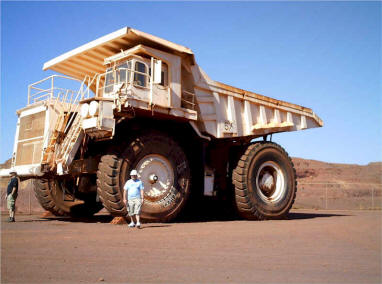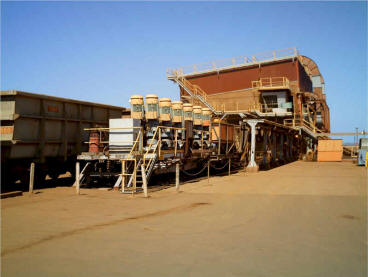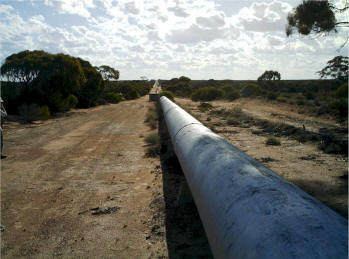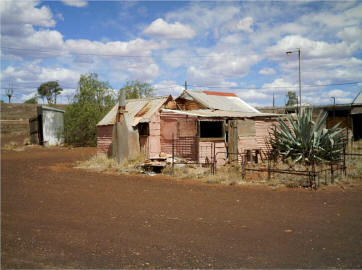|
Industrial
Archaeology in Western Australia |
|
In November I was one of a group from the UK who attended the Engineering Heritage Conference organised by the Australian Institution of Engineers. This was held at the University of Western Australia in Perth but in the two weeks before the conference we had opportunities to see various aspects of actual industrial preservation in Western Australia. Three trips were made from Perth travelling to the North, the East and the South. |
|
Dumper truck at Tom Price iron ore mine (c) Paul Saulter, 2007 The first trip was to the Pilbara region several hundred miles north of Perth to see the iron ore mining operations at Tom Price, then the dedicated railway to carry the ore to the port of Dampier. This is a spectacular current industrial operation rather than industrial archaeology. The iron ore mines themselves are enormous open pits where the ore is blasted out and transported up to the crushing and primary screening processing plant by huge dumper trucks which carry 200 tons of ore. The trains are on a similar enormous scale, 2.4 km long with a total weight of around 30,000 tons fully laden. We followed the railway for 300 kilometres in a minibus on a dirt road through uninhabited bush to reach Dampier. Here the ore is tipped from the railway wagons onto conveyor belts and stacked in piles before loading onto bulk carriers for transport to China and Japan.
Machinery for drawing wagons into unloading bay at the port at Dampier. (c) Paul Saulter, 2007 |
|
After returning to Perth, the next trip out to Kalgoorlie and the Eastern Goldfields had a much more historical flavour. We travelled to Kalgoorlie by road following the ‘Golden Pipeline’ built at the beginning of the 20th century to transport water from Mundaring Weir just outside Perth to the goldfields. The use of the word weir is a little odd as it is actually a significant sized dam and reservoir. The pipeline is still in use and retains a large proportion of the original pipe sections although the inside has now been lined with concrete. Originally the pipeline had eight pumping stations containing pairs of Worthington-Simpson steam engines. The engines remain only in number 8 station at Dedari where they are in the care of the Australian National Trust. We were able to see these in the company of Steve Smith from the Trust who would like to restore them to working order. He is working with a few volunteers to do some limited restoration work but the great problem is the tyranny of distance. The pumping station in question is hundreds of km from Perth and a couple of hours drive from Kalgoorlie, a problem both for volunteer labour to do the restoration and if they were restored to get sufficient visitors to make a museum viable.
The water pipeline to Kalgoorlie (c) Paul Saulter, 2007 |
|
In Kalgoorlie we saw modern gold mining but also learned about the history of the gold rush of the 1890s which brought thousands of prospectors from all over the world in search of a fortune. I must thank the Eastern Goldfields Historical Society members for turning out to show us their archives and give us tea and cakes. They must have the largest coverage by area of any local history society, some 300,000 sq kilometres. Around 200km north of Kaloorlie lies Leonora, where the Sons of Gwalia gold mine, first pegged in 1896 by Welsh miners, was once managed by Herbert Hoover, US President 1928 – 1932. His house is preserved as a museum together with a collection of mining relics including a large winding engine of 1912. The original mining operation closed overnight in the 1960s and the people just left leaving a ghost town of shops and little shacks that remain to this day. More recently the goldmine has reopened but as an enormous open pit operation worked with modern machinery. Again the tyranny of distance comes into play, it is a whole day excursion to reach Leonora from Kalgoorlie with just one small settlement in between and it is not on the way to anywhere – unless one is heading into the real outback.
House at abandoned mining town at Gwalia. (c) Paul Saulter, 2007 |
|
We returned to Perth by train on the standard gauge railway, part of the transcontinental linking Perth and Sydney. Western Australia originally built its railways to the 3’ 6" gauge and this remains the gauge for the extant network which is now almost exclusively used for freight. The same gauge has been used for the more recently built Perth suburban network. The transcontinental railway was built to standard gauge which means there are sections of dual gauge track connecting this railway to the port at Freemantle. |
|
Our third trip was the official pre-conference tour to the area to the south of Perth. On the first day we visited Katanning to see the former Great Southern Herald printing works and ‘Wakes Garage’ museum and then travelled to Albany on the south coast for our first overnight stay. The next day we visited Whale World - a former whaling station now converted into a museum. One of the whale chase boats complete with harpoon has been mounted on the shore. The blubber boiling apparatus remains and the enormous chain saw used for handling the head of the sperm whale. The museum told the story of whaling as it was, without too much overlaying of emotion. Whaling happened and was part of the industrial history of the southern ocean and economically significant to the town of Albany. |
|
The climate of this area of Western Australia is less extreme than the rest of the state with rain throughout the year and permanent rivers and lakes. A number of wineries have opened up of which we visited one, although this was a very modern operation using large stainless steel tanks so more a convenient lunch stop than of any historical interest. |
|
Until the 1970s the hardwood timber industry from native forests was very significant in Australia but due to the loss of these forests the industry is now based around softwood timber production from pine and blue gum plantations. To give an idea of what original hardwood forests are like we took a treetop walk in the so called valley of the giants. Here an elevated walkway has been erected in the forest canopy to get to the trees close up. Our next overnight stop was in Manjimup where we were able to admire a device known as a ‘Whim’. This word is used for a transport device for large logs with a pair of wooden carriage wheels over 10’ in diameter between which the log is suspended so it can be hauled out of the forest by a bullock or horse team. |
|
The next day the timber theme was continued when we visited a former steam driven sawmill at Donnelly River. At the time of its closure it represented the last generation of mills of this type with the log handling and saws driven by a reciprocating steam engine using a system of under floor belts and shafting. Unfortunately for a complicated set of reasons involving local heritage politics the mill has been allowed to gradually decay to the point at which the structure is now unsafe and will probably have to be demolished. We were able to get onto this site only as the conference organiser had made special arrangements and I suspect will be the last group of industrial archaeologists to see it. |
|
After this we headed to Busselton and then to Bunbury where an old wooden jetty is being preserved. The engineer in charge explained the particular problems with restoring a structure in the area of a working and expanding port and town. After an overnight stop in Bunbury we headed back to Perth, seeing on the way the swathes of new housing being built to the south of Perth as a result of the booming Western Australian economy fuelled by the demand for minerals. |
|
The heritage conference was attended by delegates from all over Australia and New Zealand as well as a UK contingent from the Newcomen Sociey and AIA. The papers covered a wide range of subjects from the timber industry to the development of wireless communication in Australia. Some of the items were specific to that part of the world such as preserving historic wooden bridges from being attacked by termites. By the nature of the colonial experience things will be regarded as candidates for preservation which in the UK would not be regarded as significant because they are of no great age or are relatively common. It also became clear from several of the presentations that industrial heritage preservation has only just been ‘discovered’ more generally in Australia with industries and public utilities appointing heritage officers. One of the papers was on the hydro-electric schemes of Tasmania and how buildings can be reused to house modern equipment. Very praiseworthy but there is the risk that such an approach could lead to the situation where there are fine buildings of various architectural styles from the 1920s to the 1970s, then nothing more recent for industrial archaeologists or the general tourist to admire in 50 or 100 years time. |
|
An enjoyable time was had by all, except for the fact that some Australian coach drivers cannot stop talking whether you want to be informed, entertained or just infuriated by their poor knowledge of things technical. |
|
I would like to thank Paul Saulter of Heritage of Industry for his efficient organisation of the visits to the Pilbara and Kalgoorlie. Report © Colin Jenkins |




